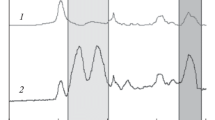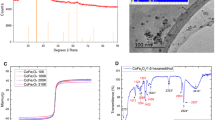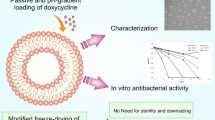Abstract
Antibiotic resistance is a serious problem facing the world; it is increasing every year due to over or misuse of antibiotics that led to developing new mechanisms of drug resistance by bacteria. In the present study Magneto-Liposomes (MLs) loaded with Erythromycin drug were designed; They were subjected to 5 and 15 mT Alternating Magnetic Field (AMF) at 100 KHz for 30 min of exposure to test the effect of exposure to the AMF on inducing the drug release rate beyond the resistance mechanism of bacteria. During exposure, the temperature of the sample was continuously recorded using IR thermometer. After exposure, the percentage of drug released was tested using UPLC-MS/MS method for every hour until 8 h then at 24 h post-exposure. Results showed an elevated temperature of 4 and 24°C in case of exposure the Erythromycin-encapsulated MLs to 5 and 15 mT respectively. Moreover, an increase in the percentage of Erythromycin release with a percentage of (0.83 ± 0.1) μg/mL and with (1.33 ± 4) × 10–7 μg/mL for exposure to 5 and 15 mT respectively, with respect to (0.24 ± 0.06) μg/mL in the control group. Exposing Erythromycin-encapsulated ML to AMF accelerated the release rate due to mechanical actuation of the nanoparticles. These findings suggest that it is possible to trigger and control the drug release by merging the targeted drug delivery system with the nanotechnology and magnetic field. Upon increasing the intensity of the AMF, the release rate increased significantly.









Similar content being viewed by others
REFERENCES
A. Hardiansyah, L.-Y. Huang, M.-Ch. Yang, et al., Nanoscale Rese. Lett. 9, 497 (2014).
P. R. Kulkarni, J. D. Yadav, and K. A. Vaidya, Int. J. Curr. Pharm. Res. 3, 10 (2011).
R. P. Liburdy and T. S. Tenforde, Radiat. Res. 108, 102 (1986)
Y. Wang and D. S. Kohane, Nature Rev. Materials 2, 17020 (2017). https://doi.org/10.1038/natrevmats.2017.20
A. Akbarzadeh, M. Samiei, and S. Davaran, Nanoscale Res. Lett. 7, 144 (2012).
S. Laurent, D. Forge, M. Port, et al., Chem. Rev. 110 (4), 2574 (2010). https://doi.org/10.1021/cr900197g
Ch. Tapeinos, in Smart Nanoparticles for Biomedicine (Elsevier, 2018), pp. 131–142. https://doi.org/10.1016/B978-0-12-814156-4.00009-4
S. L. Pal, U. Jana, P. K. Manna, et al., J. Appl. Pharmaceut. Sci. 1 (6), 228 (2011).
T. Neuberger, B. Schopf, H. Hofmann, et al., J. Magnetism Magnet. Mater. 293, 483 (2005).
J. Estelrich, E. Escribano, J. Queralt, and M. A. Bus-quets, Int. J. Mol. Sci. 16 (4), 8070 (2015). https://doi.org/10.3390/ijms16048070
L. A. Tai, P. J. Tsai, Y. C. Wang, et al., Nanotechnology 20 (13) (2009). https://doi.org/10.1088/0957-4484/20/13/135101
D. Qiu, and X. An, Colloids Surfaces B: Biointerfaces 104, 326 (2013). https://doi.org/10.1016/j.colsurfb.2012.11.033
R. I. Blumenthal, J. Nanomed. Biother. Discov. 4 (3), 1000130 (2014). https://doi.org/10.4172/2155-983x.1000130
S. Nappini, M. Bonini, F. Ridi, and P. Baglioni, Soft Matter 7 (10), 4801 (2011). https://doi.org/10.1039/c0sm01264e
A. Laouini, C. Jaafar-Maalej, I. Limayem-Blouza, et al., J. Colloid Sci. Biotechnol. 1 (2), 147 (2012). https://doi.org/10.1166/jcsb.2012.1020
S. Nappini, S. Fogli, B. Castroflorio, et al., J. Mater. Chem. B 4, 716 (2016).
Y. I. Golovin, S. L. Gribanovsky, D. Y. Golovin, et al., J. Control. Release 219, 43 (2015).
W. Zhan and C. H. Wang, J. Control. Release 285, 212 (2018). https://doi.org/10.1016/j.jconrel.2018.07.006
T. Hirsch, F. Jacobsen, H.-U. Steinau, and L. Steinstraesser, Prot. Peptide Lett. 15 (3), 238 (2008).
L. S. Tavares, M. D. O. Santos, L. F. Viccini, et al., Peptides 29 (10), 1842 (2008).
S. B. Zaman, M. A. Hussain, R. Nye, et al., Cureus 9 (6), e1403 (2017).
U. Shimanovich and A. Gedanken, J. Mater. Chem. B 4 (5), 824 (2016).
A. Gupta, S. Mumtaz, C.-H. Li, et al., Chem. Soc. Rev. 48 (2), 415 (2019).
D. Belc, C. Chen, R. Roberts, et al., in NSTI Nanotech 2005: Proc. NSTI Nanotechnology Conf. and Trade Show (2005), pp. 23–26.
R. Spera, F. Apollonio, M. Liberti, et al., Colloids Surf. B Biointerfaces 131, 136 (2015).
M. Babincova, P. Čičmanec, V. Altanerova, Bioelectrochemistry 55 (1–2), 17 (2002). https://doi.org/10.1016/S1567-5394(01)00171-2
A. Joniec, S. Sek, and P. Krysinski, Chemistry – Eur. J. 22 (49), 17715 (2016). https://doi.org/10.1002/chem.201602809
V. M. De Paoli, S. H. Lacerda De Paoli, L. Spinu, et al., Langmuir 22, 5894 (2006).
N. C. C. Lobato, A. de Mello Ferreira, and M. B. Man-sur, Separat. Purif. Technol. 168, 93 (2016).
E. Touitou, L. Bergelson, B. Godin, and M. Eliaz, J. Control Release 65, 403 (2000).
M. Rady, I. Gomaa, N. Afifi, and M. Abdel-Kader, Int. J. Pharmaceut. 548 (1), 480 (2018).
G. Podaru, R. Dani, H. Wang, et al., J. Phys. Chem. B 118 (40), 11715 (2014). https://doi.org/10.1021/jp5022278
C. A. Monnier, D. Burnand, B. Rothen-Rutishauser, et al., Eur. J. Nanomed. 6 (4), 201 (2014). https://doi.org/10.1515/ejnm-2014-0042
A. R. O. Rodrigues, B. G. Almeida, J. M. Rodrigues, et al., RSC Advances 7 (25), 15352 (2017). https://doi.org/10.1039/c7ra00447h
K. Y. Vlasova, A. Piroyan, I. M. Le-Deygen, et al., J. Colloid Interface Sci. 552, 689 (2019). https://doi.org/10.1016/j.jcis.2019.05.071
Author information
Authors and Affiliations
Corresponding author
Ethics declarations
Conflict of interests. The author declares that he has no conflict of interest.This work does not contain any studies involving animals or human subjects performed by the author.
Additional information
Abbreviations: AMF, alternating magnetic field; TEM, transmission electron microscopy; HPLC, high-performance liquid chromatography.
Rights and permissions
About this article
Cite this article
Bassant M. Salah, Rady, M., Abdel-Halim, M. et al. Alternating Magnetic Field Induced Membrane Permeability in Erythromycin Magneto-Liposomes A Potential Solution to Antibiotic Resistance. BIOPHYSICS 66, 264–272 (2021). https://doi.org/10.1134/S0006350921020196
Received:
Revised:
Accepted:
Published:
Issue Date:
DOI: https://doi.org/10.1134/S0006350921020196




